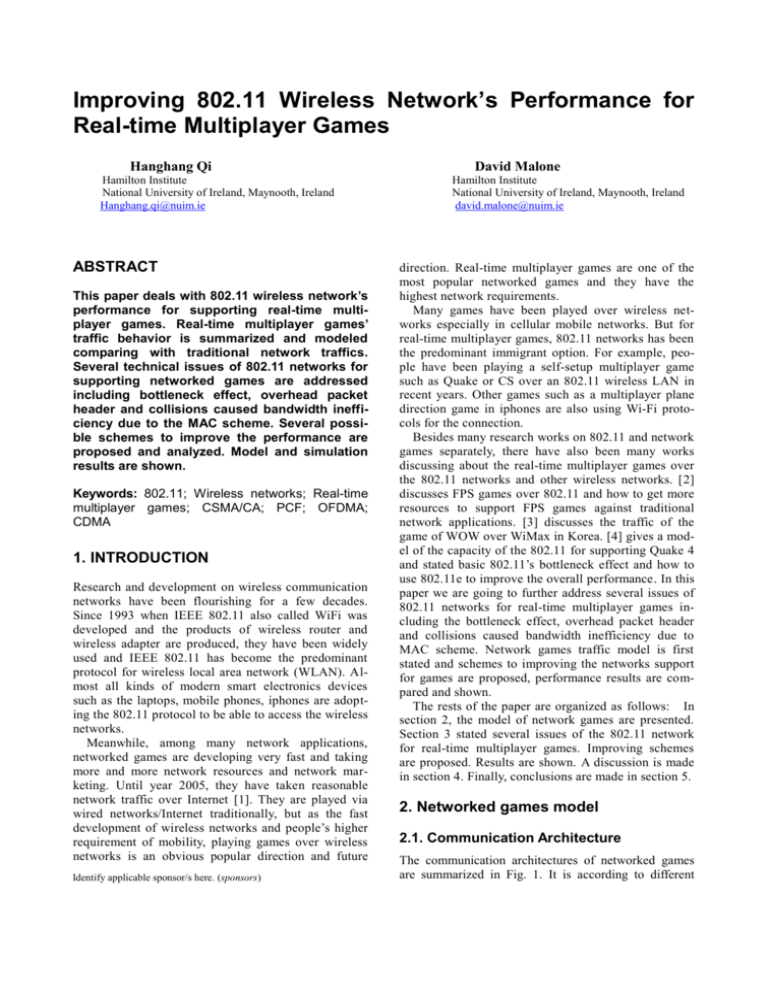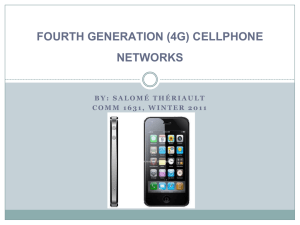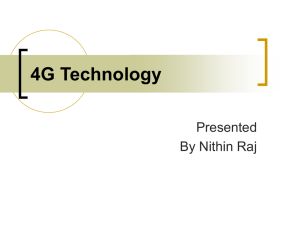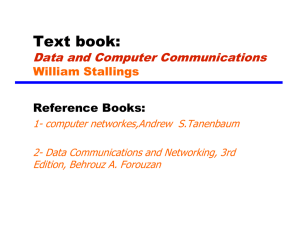486 IEEE TRANSACTIONS ON NEURAL
advertisement

Improving 802.11 Wireless Network’s Performance for Real-time Multiplayer Games Hanghang Qi Hamilton Institute National University of Ireland, Maynooth, Ireland Hanghang.qi@nuim.ie ABSTRACT This paper deals with 802.11 wireless network’s performance for supporting real-time multiplayer games. Real-time multiplayer games’ traffic behavior is summarized and modeled comparing with traditional network traffics. Several technical issues of 802.11 networks for supporting networked games are addressed including bottleneck effect, overhead packet header and collisions caused bandwidth inefficiency due to the MAC scheme. Several possible schemes to improve the performance are proposed and analyzed. Model and simulation results are shown. Keywords: 802.11; Wireless networks; Real-time multiplayer games; CSMA/CA; PCF; OFDMA; CDMA 1. INTRODUCTION Research and development on wireless communication networks have been flourishing for a few decades. Since 1993 when IEEE 802.11 also called WiFi was developed and the products of wireless router and wireless adapter are produced, they have been widely used and IEEE 802.11 has become the predominant protocol for wireless local area network (WLAN). Almost all kinds of modern smart electronics devices such as the laptops, mobile phones, iphones are adopting the 802.11 protocol to be able to access the wireless networks. Meanwhile, among many network applications, networked games are developing very fast and taking more and more network resources and network marketing. Until year 2005, they have taken reasonable network traffic over Internet [1]. They are played via wired networks/Internet traditionally, but as the fast development of wireless networks and people’s higher requirement of mobility, playing games over wireless networks is an obvious popular direction and future Identify applicable sponsor/s here. (sponsors) David Malone Hamilton Institute National University of Ireland, Maynooth, Ireland david.malone@nuim.ie direction. Real-time multiplayer games are one of the most popular networked games and they have the highest network requirements. Many games have been played over wireless networks especially in cellular mobile networks. But for real-time multiplayer games, 802.11 networks has been the predominant immigrant option. For example, people have been playing a self-setup multiplayer game such as Quake or CS over an 802.11 wireless LAN in recent years. Other games such as a multiplayer plane direction game in iphones are also using Wi-Fi protocols for the connection. Besides many research works on 802.11 and network games separately, there have also been many works discussing about the real-time multiplayer games over the 802.11 networks and other wireless networks. [2] discusses FPS games over 802.11 and how to get more resources to support FPS games against traditional network applications. [3] discusses the traffic of the game of WOW over WiMax in Korea. [4] gives a model of the capacity of the 802.11 for supporting Quake 4 and stated basic 802.11’s bottleneck effect and how to use 802.11e to improve the overall performance. In this paper we are going to further address several issues of 802.11 networks for real-time multiplayer games including the bottleneck effect, overhead packet header and collisions caused bandwidth inefficiency due to MAC scheme. Network games traffic model is first stated and schemes to improving the networks support for games are proposed, performance results are compared and shown. The rests of the paper are organized as follows: In section 2, the model of network games are presented. Section 3 stated several issues of the 802.11 network for real-time multiplayer games. Improving schemes are proposed. Results are shown. A discussion is made in section 4. Finally, conclusions are made in section 5. 2. Networked games model 2.1. Communication Architecture The communication architectures of networked games are summarized in Fig. 1. It is according to different degree of deployment [5]. Initially, from a single computer with split screen, it has developed to P2P, server-clients and server clusters architectures. The server-client architecture is still the most used and we mainly deal with this architecture in this paper. 2.3. Server-Client Traffic model For server-client real-time games, periodical packets are transmitted between server and clients. The inter-arrival time is almost regular. The packet size is varying and the traffic flows parameters from server to client and from client to server are different. Taking Quake 4 as an example which we specifically studied in our wireless test, the traffic is summarized in table 1. Quake 4 S to C C to S Inter-arrival time (ms) 15.38 71.43 No. packets/s 65 14 Packet size (bytes) 57 24.8n+45.4 Table 1 Quake 4’s traffic model Literatures [9] show that most server-client games have the similar traffic mode but with different parameters. Because of the limit of space and time, we do not show the other games parameters here. Fig. 1 Degrees of deployment: (a) a split screens on a single computer (b) a peer-to-peer architecture, (c) a client/server architecture and (d) a server-network architecture. [5] 2.2. Information Models of Real-time Games Considering a general real-time multiplayer game with n players, each player needs enough information to construct the virtual game world. Each player is both an information source and an information sink. Let Mi be the information received from station i, L be local generated information. R is the information required locally. For n \i M i 1,2,...n j 1 To sum up (n 1) n Li Ri n n M L R i 1 n j i i 1 i i 1 i nR nL n 1 n 1 i 1 R L Mi n 1 n 1 M i For the server to client architecture, information exchange between server and clients can be modeled as: Ss f s ( I c1 , I c 2 ,..., I cn ) I c1 I c 2 ... I cn I si g si ( S s ) Sci f ci ( I si ) I ci g ci ( Sci ) Ss, Sci , Isi, and Ici are respectively server’s state information, client i’s state information, information flow from server to client i and information flow from client i to server 3. 802.11 for Real-time Multiplayer Games 3.1. Bottleneck effect 802.11 MAC layer uses CSMA/CA scheme. The basic CSMA/CA scheme ensures every station to have equal opportunity to access the channel. Although the detailed protocol can be referred from any books or documents for 802.11 [6] [7], we give some introductions of how 802.11 MAC works as belows. In the 802.11 network, every station, who has a packet to transmit, listens to the channel first. If the channel is sensed idle (no station is transmitting), each station chooses a random countdown number uniformly from 0 to CWi (initial is CWmin). In the next time slot, if the channel is still sensed idle, the stations reduce the countdown number by 1. When the countdown number comes to 0, the station transmits the packet. When the channel is sensed busy (any one or more stations are transmitting), the station freezes its countdown number until the channel is sensed idle again. Sometimes, multiple stations would come to the countdown number 0 and then start to transmit at the same time. A collision will result. The stations involved in the collision will each choose a new countdown number again from 0 to 2CWi to avoid further collisions. After the station successfully transmits, CW becomes CWmin. This process is like that each station who wants to transmit throws a dice independently, and then waits until the countdown number comes to 0. When a collision happens, to avoid another collision, the station chooses a larger dice (twice larger here). When a successful transmission happens, the station comes back to use the initial dice. This basic CSMA/CA scheme ensures every station to have equal opportunity to access the channel. However, in the wireless game network, AP and server obviously have more game traffic than clients, because they are behaving like the pivots. So equal opportunity makes bottlenecks at the AP and the server actually. 802.11e allows 4 different MAC parameters to adjust and gives different station different QoS and different priority. TXOP (transmission opportunity) is one of the 4 MAC parameters. How many clients a basic 802.11 network can support and how 802.11e can improve can be modeled with extended nonsaturated heterogeneous Bianchi model. This is done in the previous works [4]. Basically, it is that the binary exponential backoff CSMA/CA scheme can be modeled with 2D Markov chain with different offer load parameters and 11e parameters fitted to get a relationship between transmission rate and collision rate and the collision rate p is combined with transmission rate τ by the definition of collision: 1- p =1-(1τ )n-1 equations here. By solving the group of nonlinear equations, we can get the transmission rate and then the throughput, delay, jitter etc. Detailed information can be referred to [4]. The main results are shown in Fig. 2. Fig. 2 Basic 802.11’s performance vs. 802.11e to prioritize the AP and the server 3.2. Overhead Packet Headers 802.11 wireless networks adopt the Internet design’s layer concept which is basically for scarcely random-like access. New network application which has streaming-like traffic such as voice, video and game make current protocol and routers inefficient. Roberts, one of the Internet founders, has addressed this issue in [8]. 802.11 networks also exit this issue. If the concept of streaming can apply, the size of the packet header can reduce for the 802.11 wireless networks, 802.11 can becomes more efficient for games and support more players within a single 802.11 network. Most real-time games use UDP traffic. The game packet format, UDP packet format and IPv4 packet format are shown in Fig.3. IP header UDP header Payload Tail oad UDP IPv4 Fig.3 UDP and IPv4 packet format 40 35 header+tail=32bytes@1Mbps 30 25 20 15 0 10 20 30 40 Data rate (Mbps) 50 200 150 100 50 head(tail) speed from 1Mbps to 5Mbps 10 20 30 40 Data rate (Mbps) 50 140 120 60 250 0 0 maximum number of players supported 45 maximum number of players supported maximum number of players supported maximum number of players supported 50 60 data rate@11Mbps 120 100 80 60 40 1 2 3 4 header+tail rate (Mbps) 5 110 100 data rate@11Mbps 90 80 70 60 50 40 0 5 10 15 20 size of header+tail (Bytes) 25 30 Fig.4 Number of players with the data speed, header (and tail) speed and header (and tail)’s size Suppose the size of header and tail of a game packet is h and t. The size of payload (data) is p. Data rate for header and tail is Bht, and for data is Bp. Time for one packet is t, maximum number of packets in one second is n, number of players the network can support is N. t (h p) / Bht p / Bp n 1/ t N n/ λ is the number of packet per sec one client transmits. The results are shown in Fig. 4 3.3. Contentions vs. Contention Free On difference between 802.11 and the Ethernet is that the 802.11 uses CSMA/CA (collision avoidance) instead of CSMA/CD (collision detection). This is caused because of the hardware consideration. The 802.11 protocol considers low power consumption and low weight of the wireless device. So unlike Ethernet network adaptor which can work duplex, the current 802.11 device is design to work only simplex. When the 802.11 device transmits, it can’t listen. So collision detection is not enabled. Collision detection means that when a station is transmitting, it listens to the channel at the same time. If others happen to transmit at the same time, this station can detect it, and stop transmitting immediately, and select a new counter. So, this CSMA/CA 802.11 feature waste some of the bandwidth, for network applications especially for networked games which require more bandwidth, low delay and higher stability. Again, no matter CSMA/CA or CSMA/CD, they are decentralized distributed schemes and they do not avoid collisions. They do not utilize the full bandwidth of a network, especially when the number of stations is large. For the real-time multiplayer games whose traffic mode is exactly known and pretty regular, using centralized schemes to utilize the full bandwidth is more efficient and possible. We propose three possible schemes which can work well for real-time multiplayer games: 802.11 PCF scheme, bandwidth division methods: OFDMA and CDMA Besides CSMA/CA DCF, the 802.11 also defines a PCF itself. It is like a polling token ring scheme. The AP is the point which controls all the transmissions’ order of the other stations. This is not efficient for random traffic, but it works well for real-time multiplayer games whose traffic is regular and periodical. Assuming the transmissions are perfectly ordered, there would be no collisions. This is very easy to implement. It does not change anything of 802.11 and it is still simplex for the stations. Some extra information may be needed for each packet so the packet size and inter-time between packets would be increased. The two bandwidth division methods are DFDMA and CDMA: OFDMA: Orthogonal Frequency-Division Multiple Access (OFDMA) is a multi-user version of the popular Orthogonal frequency-division multiplexing (OFDM) digital modulation scheme. Multiple access is achieved in OFDMA by assigning subsets of subcarriers to individual users (in games they are individual players). This allows simultaneous low data rate transmission from several users. CDMA: Code division multiple access (CDMA) is a channel access method utilized by various radio communication technologies. It should not be confused with the mobile phone standards called cdmaOne and CDMA2000 (which are often referred to as simply CDMA), which use CDMA as an underlying channel access method. One of the basic concepts in data communication is the idea of allowing several transmitters to send information simultaneously over a single communication channel. This allows several users to share a bandwidth of different frequencies. This concept is called multiplexing. CDMA employs spread-spectrum technology and a special coding scheme (where each transmitter is assigned a code) to allow multiple users to be multiplexed over the same physical channel. By contrast, time division multiple access (TDMA) divides access by time, while frequency-division multiple access (FDMA) divides it by frequency. CDMA is a form of spread-spectrum signaling, since the modulated coded signal has a much higher data bandwidth than the data being communicated. Both OFDMA and CDMA are frequency division techniques. Compared to the traditional 802.11 protocol, they are more efficient in using the bandwidth to support connection-oriented communication applications, thus more fitted for real-time multiplayer games. The price they will pay is higher complexity on the devices and power consumptions as they need to be working duplex and extra algorithm codex hardware. The implementation of them will change more for the current 802.11 devices than PCF but can gain more bandwidth utility. 4. Discussions All the background traffics are not considered here. This is our future work. Simply speaking, background traffic will surely cause some jitter for the wireless games and takes up some of the bandwidth from the whole network for games. 5. CONCLUSIONS 802.11 networks are supporting and can support real-time multiplayer games. But due to the nature of networked games traffic, some improvements for the 802.11 networks can still be made. Several 802.11 network issues including the bottleneck effect, overhead packet header and inefficiency of the MAC scheme are addressed and possible solutions are presented. The results of improvement and limitations are shown. 6. REFERENCES [1] [2] [3] [4] [5] [6] [7] [8] [9] N. Shah and C. Haigh. The video game industry, an industry analysis, from a VC perspective. 2005 J. C B. Carrig, D. Denieffe, and J. Murphy. Supporting first person shooter games in wireless local area networks. In Personal, Indoor and Mobile Radio Communications, 2007. Xiaofei Wang; Hyunchul Kim; Vasilakos, A.V.; Kwon, T.; Yanghee Choi; Sunghyun Choi; Hanyoung Jang; , "Measurement and analysis of World of Warcraft in mobile WiMAX networks," Network and Systems Support for Games (NetGames), 2009 8th Annual Workshop on , vol., no., pp.1-6, 23-24 Nov. 2009 Hanghang Qi; Malone, D.; Botvich, D.; , "802.11 wireless LAN multiplayer game capacity and optimization," Network and Systems Support for Games (NetGames), 2009 8th Annual Workshop on , vol., no., pp.1-6, 23-24 Nov. 2009 J. Smed, T. Kaukoranta, and H. Hakonen. Aspects of networking in Multiplayer Computer Games. The Electronic Library, 20(2):87–97, 2002. Part 11: wireless LAN medium access control (MAC) and physical layer (PHY) specifications, IEEE 802.11. Matther S. Gast. 802.11 wireless networks: the definitive guide (2nd edition). O’Reilly. 2005 Larry Roberts. The Internet is broken. Let’s fix it. IEEE spectrum. July 2009 G. Armitage, M. Claypool, and P. Branch. Networking and online games: understanding and engineering multiplayer Internet games. John Wiley & Sons, Ltd. Chichester, England, 2006







